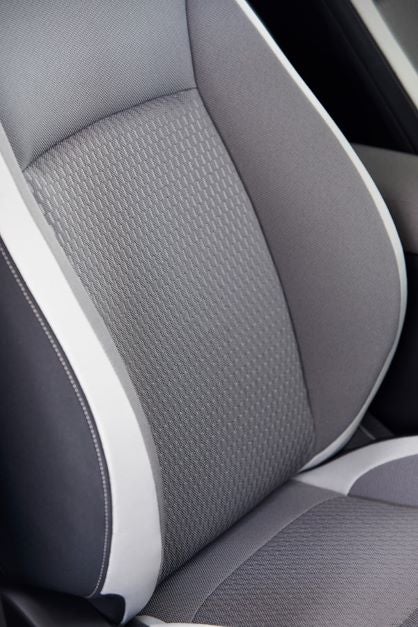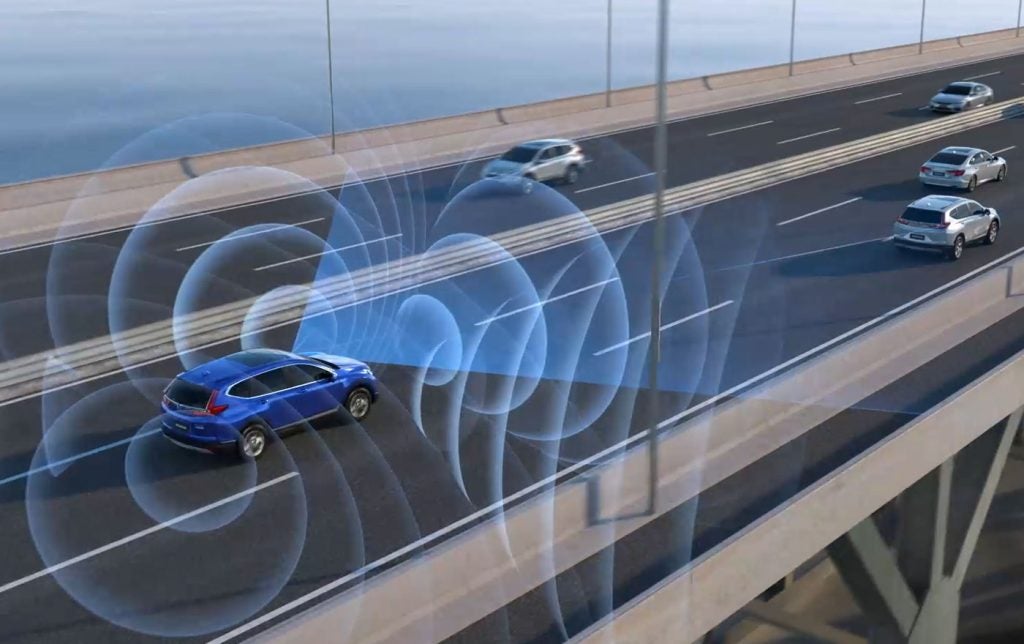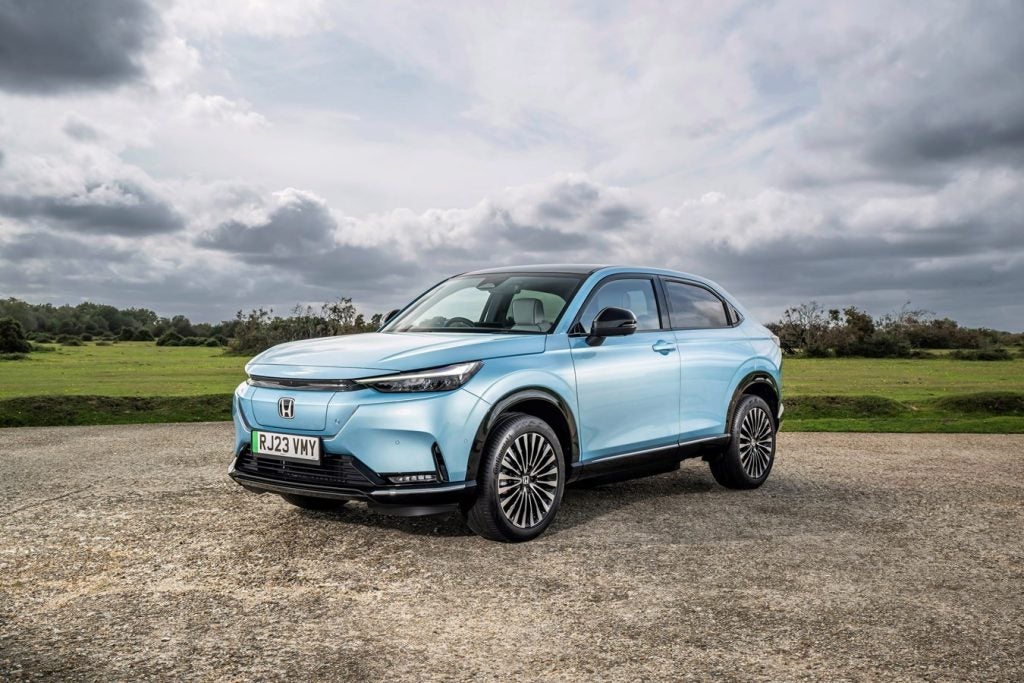
There are four trim levels for the Jazz: SE, SR, EX and Crosstar EX. The on-trend SUV styling of the Crosstar Executive variant is available with the same hybrid powertrain and interior features as the standard model, it provides increased ride height, ‘water-resistant fabric seats’ and integrated roof rails. Its distinguishing marks include a bolder front grille design, black cladding around the wheel arches and stylish side sills. The Crosstar-specific 16-inch silver and black alloy wheels complete the look. It is also slightly longer (by 46mm), higher (37mm) and wider (31mm) than standard Jazz.

Inside story
The latest generation Jazz, also known as ‘Fit’ in some markets, has even more space and technology than its predecessor. Honda’s ‘magic’ seats fold and collapse into a range of configurations for carrying passengers and stuff. We have seen this same arrangement on other Honda models for quite a while but it’s still impressive. The luggage capacity (with rear seats up) starts from 298 litres and increases to 1,199 litres (to the roof with the rear seats down). This is partly thanks to the packaging of hybrid drivetrain components into the chassis and within the engine bay.
Also key to maximising cabin room is the positioning of the fuel tank in the centre of the chassis beneath the front seats, which is a first in this class. The packaging and overall design also permit a wider tailgate opening and a new stepless flat floor that makes loading and unloading the boot easier.

Front seat occupants benefit from Honda’s newly developed body stabilising seat frame with mat-structure support and a 30mm seat padding thickness increase. These changes enhance comfort levels and provide greater lumbar support to minimise fatigue.
To further increase driver comfort, the position of the brake pedal has been changed to optimise the foot angle offering a more natural foot placement. In addition, to support taller drivers, the quirky two-spoke leather steering wheel is now two degrees more upright and the range of adjustment has been revised to allow the wheel to be positioned closer to the driver. All in all, it makes for a pleasant place to sit.
How well do you really know your competitors?
Access the most comprehensive Company Profiles on the market, powered by GlobalData. Save hours of research. Gain competitive edge.

Thank you!
Your download email will arrive shortly
Not ready to buy yet? Download a free sample
We are confident about the unique quality of our Company Profiles. However, we want you to make the most beneficial decision for your business, so we offer a free sample that you can download by submitting the below form
By GlobalData
Further back, adults seated in the second-row of the Crosstar travel in relative comfort thanks to the redesign of the seat structure allowing the hinges to be moved outside of the passenger hip points. Rear leg space of 986mm – made possible by the torsion beam suspension layout – and seat padding thickness that has been increased by 24mm adds to the comfort levels. Designers have also added smartphone pockets in the back of the front seats for rear occupants to use.

Forward visibility is good, partly because the A-pillar thickness has been more than halved from 116mm to 55mm with the rear pillar now providing the main structural strength. This, along with the hidden windscreen wipers and deep, flat dashboard. provide the driver and front seat passenger with a good field of vision. The sweeping A-pillars and door-mirror design minimise noise and drag caused by wind turbulence. The highly raked windscreen and front quarter glass allow more natural light to flow into the cabin resulting in a greater sense of space for occupants.
Connectivity and infotainment
Connected infotainment features and apps can be accessed via touchscreen or voice activation, including weather, parking locations, music, navigation, location finding, and phone services.
The LCD touchscreen interface is designed to minimise driver distraction; operation time for the most regularly-used controls is reduced by 58% compared with the previous model. The nine-inch touchscreen allows you to pinch, swipe and tap through the Honda Connect in-car audio and information system. This includes DAB and internet radio (with a welcome dial to control the volume rather than a touch-slider), phone interface and Bluetooth connectivity, and rearview parking camera with dynamic guidelines.

Beneath the touchscreen is a no-nonsense cluster to operate the HVAC with chunky dials and buttons. Plenty of storage spaces and cubby holes are dotted around the cabin, including a useful pair of glove boxes.
The suite of apps can be supplemented by smartphone mirroring, enabled by Android Auto and Apple CarPlay, with the latter available via wireless connection for the first time in the Jazz. Even the owner’s manual can be accessed via the onboard touch infotainment system or through AI voice control for customers who have subscribed to Honda Personal Assistant.
My Honda+ app provides secure access to a range of in-car functions, including convenience and security features. For example, journey information can be set up and sent from the app to the car and it can also lock and unlock the car remotely.
For additional security, the app provides location monitoring and car tracking via GPS. Intelligent Geofencing can also be activated to alert the owner if the vehicle breaches a pre-set ‘geofence’ zone, plus a security notification delivered to the smartphone app if the car’s security alarm is activated.
The Honda Personal Assistant assesses command inputs with a level of complexity beyond the capabilities of other voice-activated virtual assistants. The system understands several levels of interaction, for more exact responses to specific queries. An owner can ask, for example: “OK Honda, find me an Italian restaurant with free parking, WiFi, and that’s open now.”
All vehicles feature E-Call for roadside assistance as standard. In the event of an emergency, such as airbag deployment, the car’s location is automatically shared with the relevant emergency services.
The Crosstar incorporates an eight-speaker sound system that includes an aluminium dome tweeter, Honda-unique Kevlar cone speakers and a subwoofer in the rear luggage space. The tweeter is built into the inner door handle, while the subwoofer box is placed where it doesn’t intrude on luggage space.
Advanced driver assistance systems
Every Jazz comes with a number of advanced driver assistance system (ADAS) technologies, including city-brake active (to help avoid low-speed accidents), forward collision warning (detects the risk of collision by recognising the vehicle ahead, using a camera), traffic sign recognition system, intelligent speed limiter (combines two otherwise independent safety systems – adjustable speed limiter and traffic sign recognition system), lane departure warning (increasingly common across the segment) and high-beam support system (which is surprisingly quick at adjusting the headlight beam).
A new wider angle, higher definition camera replaces the multi-purpose camera and City-Brake Active System sensor set-up of the previous-generation Jazz. The camera recognises a range of road surfaces and traffic characteristics. These include detecting if the car approaches the outer edge of pavement (into a grass or gravel border), an oncoming vehicle, or drifting into another lane without indicating, and road signs. The camera is also able to eliminate condensation for a constantly clear field of view.
On the road
The Crosstar is fairly quiet on the road. More insulation and sound deadening material has been fitted to reduce road noise from road surface variations, improving cabin ambience in three frequency ranges. The cabin and floor panels are separated to reduce resonance through the car’s structure, and sound insulation has been added around the dashboard. Noise from the engine has also been reduced through the use of resin material to the engine mount to insulate the engine bay. The sound-absorbing materials and thicker glass contribute to a 10 per cent reduction in noise intrusion to the cabin over the previous Jazz model. Above all, it’s all about economy and practicality and the hybrid easily averages 63 mpg. Rival models include the Ford Fiesta Active, Citroen C3 Aircross and VW T-Cross.






